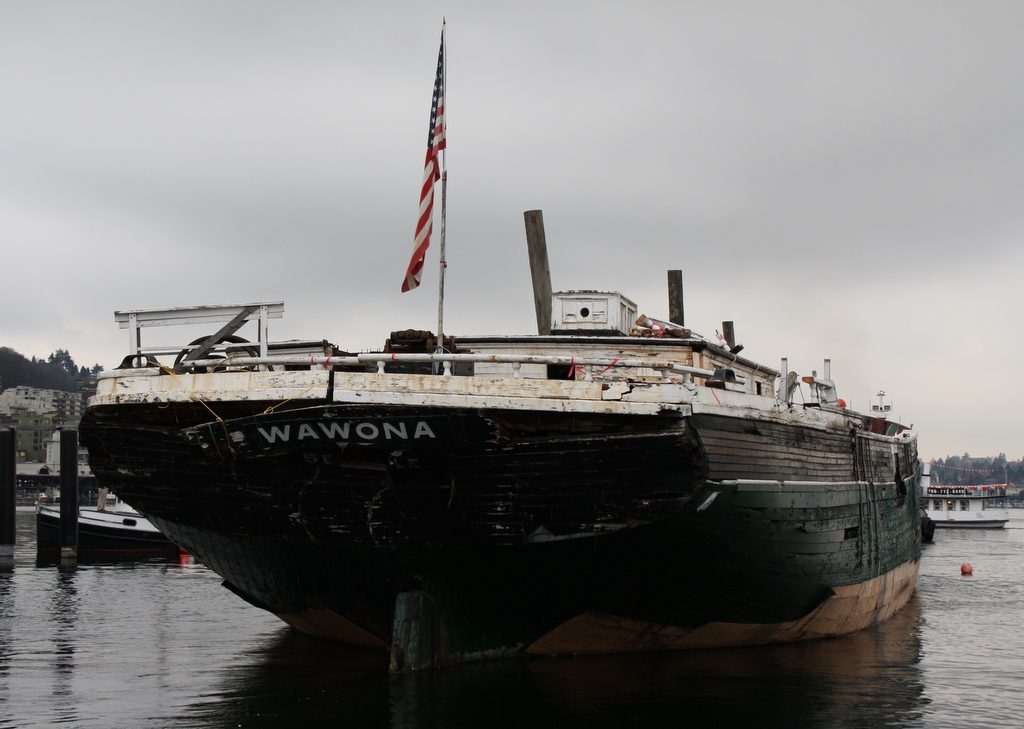On March 4, 2009, By Tom Brown – The lumber-carrying and cod-fishing schooner Wawona, her masts cut to stumps and name board askew on the crumbling stern, is towed from her longtime berth in Waterway 4 in South Lake Union to the Lake Union Drydock Company, where she will be further documented and dismantled. The ship’s last voyage, at most a half-mile at the end of the tugboat Flyer’s towline, is uneventful, but sad for the many people who have worked for 46 years to save the vessel.
The Wawona’s end came just a few months shy of its 112th birthday; the Wawona was launched in September 1897 at Bendixen’s Shipyard in Fairhaven, California. The 165-foot vessel hauled lumber from Washington forests to California for 17 years, then was sold to Robinson Fisheries of Anacortes, Washington, which employed her as a mothership to a fleet of 18 dories in the Bering Sea cod fishery for three decades.
In 1964, years after her working life ended, the Wawona was bought by Seattle civic leaders, including City Councilman Wing Luke, restaurateur Ivar Haglund, and civic activist Kay Bullitt, for use as a museum ship. But they were never able to raise the money needed to restore the vessel. Meanwhile, rain and a powder-beetle infestation took their toll. The last estimate, in 2005, was that restoration would cost $15 million, with a continuing annual maintenance bill of $1 million (Bendixen built the Wawona for $29,075).
Instead of restoration, the decision was made to bring in a team of maritime archaeologists to extensively document the Wawona. Dr. David Stewart of East Carolina University, who led the digital archiving of the vessel’s lines and construction techniques, said that, “Making the decision to archive and dismantle the Wawona was difficult, but a very forward thinking step … instead of perpetually funding the maintenance of a decaying ship, in many cases it is better to get a good recording of it and put those resources into further study (NWSeaport).” One result of the archiving will be a 3-D image of the vessel.
Completing the survey of the Wawona, removing “historically significant” parts for future display in Lake Union Park and dismantling the hull was to take about five weeks. About 90 to 95 percent of the Wawona, the first vessel to be placed on the National Register of Historic Places, will go to a landfill. The sole remaining vessel of the type is the C. A. Thayer, which is maintained as a museum ship in San Francisco.
“I really felt, after all this time, that all the preparation to move her, the documenting efforts, the move, was a real example of death with dignity,” said Kay Bullitt (Harrell).

Sources
By Tom Brown – HistoryLink.org
Debera Carlton Harrell, “Wawona Towed Off to Dismantling,” Seattle Post-Intelligencer, March 5, 2009, (http://seattlepi.nwsource.com); Erik Lacitis, “Historic Schooner Wawona Heads for Demise,” The Seattle Times, March 5, 2009 (http://seattletimes.nwsource.com); News release, NWSeaport.org, March 4, 2009 (http://nwseaport.org); HistoryLink.org Online Encyclopedia of Washington State History, “Wawona, Pacific Lumber and Cod Fishing Schooner” (by Larry E. Johnson), http://historylink.org/ (accessed March 5, 2009).
* Noteworthy
1628 – The Massachusetts Bay Colony is granted a Royal charter.
1681 – Charles II grants a land charter to William Penn for the area that will later become Pennsylvania.
1789 – In New York City, the first Congress of the United States meets, putting the United States Constitution into effect. The United States Bill of Rights is written and proposed to Congress.
1797 – John Adams is inaugurated as the 2nd President of the United States of America, becoming the first President to begin his presidency on March 4.
1957 – The S&P 500 stock market index is introduced, replacing the S&P 90.
